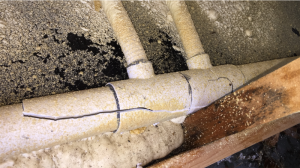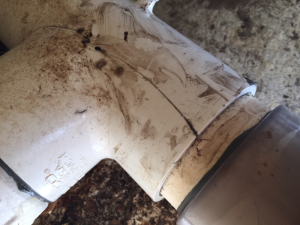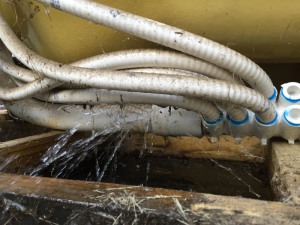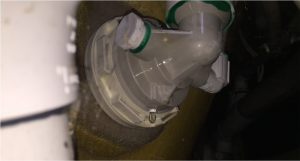When you drain your hot tub, either by the built-in drain hose or a pump, you remove about 97% of the water. That means you could still have 5-10 gallons inside your pipes. In the winter, that water freezes, often cracking the pipes.
A cracked pipe can usually be fixed, assuming we can reach it. The real problem is that most winter freeze ups damage multiple pipes, and we can’t even find the little leaks until we fix the big leaks.
Here’s a big leak: a 1.5 inch pipe on the inside floor of the tub with an 18 inch crack.

Big hot tub leaks can be easy to find and quick to repair.
The problem is that a leak like this is so large, water flows out the instant you try to fill the tub. Until this leak is repaired, you’ll never get enough water into the hot tub to find what else is leaking.
Assume we’ve found and repaired this leak on our first visit to your home. We recommend that glue is allowed to set for 24 hours before allowing contact with water, so you wait until the next day to fill your tub.
The next day, when you fill the tub, you see water is still leaking out.
A second service call is scheduled and this time we find water running out of the back of a pipe from a crack that’s higher off the ground inside your tub. And that makes sense. Since the first leak was on the ground, the water was never able to reach the level in the tub where the second leak is found. Add to that the fact that the crack is in the back of the pipe and can’t even been found by visual inspection; the only way we can find it is by following the trail of water and using a camera.
Assume we repair this second leak and you fill
the tub up again after waiting 24 hours. Everything looks good, so you turn on the tub and find still more water leaking out. This time it’s shooting out from small tubing.
Those thinner tubes supply your jets with water, and may only leak when the jets are turned on. And when those tubes leak, they will leak big time. After all, you’ve got a 2 or 3 horsepower pump pushing the water through them.
This time, the leaks are deeper inside the tub. And special PVC piping called “manifolds” are damaged. Additionally, the manufacturer of your tub probably glued two or three manifolds together, and often all of those manifolds need to be replaced because there is no gluing surface between them.
So, after a third, more time consuming service call with specialized hot tub parts that you can’t get at the local hardware store, you let the glue set for 24 hours and refill it.
This time, no water flows out from the sides. Finally. You’ve got it all repaired. However, you notice a slight damp spot even after three sunny days when the ground around your tub should be dry. Maybe you notice the water level getting slightly lower.
A fourth service call finds several jets with water dripping ever so slightly from underneath.
Because the jets are usually mounted in the wall of the tub, they never show leaks until the tub is filled up. But wait, how did a winter freeze cause jets to leak if we said that the water is trapped in the pipes on the bottom?
A few ounces of water trapped inside the jet over the winter may have frozen. Since it had nowhere to expand, it pushed the jet away from the tub wall. Sometimes the mounting nut can be tightened and the problem is resolved. Sometimes the jet housing is warped and needs to be replaced. Often, the homeowner will try to tighten the mounting nut and crack the housing.
What’s the take-a-way from this story?
You can’t “just” drain your hot tub for the winter. Compressed air needs to be forced through every single pipe to remove any water. Even a few ounces can cause damage. After your pipes are thoroughly dry, you need to add antifreeze, because there is always going to be a few ounces in the lower pipes that you don’t see and can’t drain out.
Of course, you can do what half of our customers do: keep the hot tub operating over the winter. Nothing beats sitting in a hot tub with a glass of wine under a snowy January evening.
For more information or to schedule a service call to resolve your hot tub problems, contact us at 201-897-7900 or 732-894-4494. You can also reach us by email through this link.




